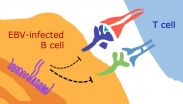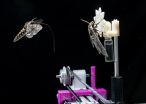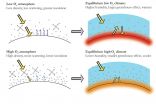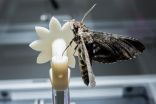(Press-News.org) Lehigh University engineers, materials scientists and chemists will present their innovative breakthroughs to a national showcase of investors and industrial partners at the TechConnect 2015 World Innovation Conference and National Innovation Showcase in Washington on June 14-17.
Working at the junction of engineering and health, the Lehigh innovations include a nanoscale device that captures tumor cells in the blood, a bioengineered enzyme that scrubs microbial biofilms and the creation of a safe and efficient chemical reagent that is stable at room temperature.
These Lehigh presentations are all National Innovation Awardees, chosen through an industry-review process of the top 20 percent of annually submitted technologies and based on the potential positive impact the technology will have on industry.
Bioengineer Yaling Liu (http://www.lehigh.edu/~inmem/faculty/liu.html) has developed a tiny device that can capture tumor cells circulating in the blood and potentially indicate disease type, as well as genetic and protein markers that may provide potential treatment options. http://www.techconnectworld.com/World2015/participate/innovation/pop.html?id=360
Lehigh chemical and biomolecular engineer Bryan Berger (http://www.lehigh.edu/~inberger/Welcome.html) wants to improve food safety and keep medical devices clean with an enzyme he's bioengineered that attack biofilms.
Chemist David Vicic (https://chemistry.cas2.lehigh.edu//faculty/david-vicic) has created a new chemical reactant that is stable at room temperature, potentially eliminating the use of traditional hazardous regents.
TechConnect is one of the largest multi-sector gathering of technology IP, technology ventures, industrial partners, and investors in the world and brings together the world's top technology transfer offices, companies, and investment firms to locate the most promising technologies and early stage companies from across the globe.
Attendees include innovators, funding agencies, national and federal labs, international research organizations, universities, tech transfer offices and investment and corporate partners. The 2015 TechConnect World Innovation event encompasses the 2015 SBIR/STTR National Conference, the 2015 National Innovation Summit and Showcase, and Nanotech2015 - the world's largest nanotechnology event.
A complete list of Lehigh innovations at TechConnect 2015:
A method to cheaply manufacture quantum dots using bacteria, by principal researcher Bryan Berger
http://www.techconnectworld.com/World2015/a.php?i=510
Bioengineered enzymes that safely and cheaply fight bacterial biofilms
http://www.techconnectworld.com/World2015/a.php?i=540
Principal investigator: Bryan Berger (http://www.lehigh.edu/~inberger/Welcome.html)
A multiplexing optical coherence tomography technology 20 times faster than current systems that preserves image resolution and allows synchronized cross-sectional and three-dimensional (3D) imaging.
http://www.techconnectworld.com/World2015/a.php?i=575
Principal investigator: Chao Zhou (http://www.ece.lehigh.edu/~zhou/)
An effective, low-cost alternative microfluidic device that closely mimics blood vessels and can mimic disease conditions
http://www.techconnectworld.com/World2015/a.php?i=377
Principal investigator: Yaling Liu (http://www.lehigh.edu/~inmem/faculty/liu.html)
Creation of a miniature medical oxygen concentrator for personal use of chronic obstructive pulmonary disease (COPD) patients
http://www.techconnectworld.com/World2015/a.php?i=580
Principal investigator: Mayuresh Kothare (http://www.lehigh.edu/~mvk2/)
A biomedically superior bioactive glass that enables the production of porous bone scaffolds that can be tailored to match the tissue growth rate of a given patient type.
Principal investigator: Himanshu Jain (http://www.lehigh.edu/matsci/faculty/jain/jain.htm)
A new distributed-feedback technique that dramatically improves the laser beam patterns and increase the output power levels of semiconductor lasers
Principal investigator: Sushil Kumar (http://www.ece.lehigh.edu/index.php?page=sushil-kumar)
A new pretreatment process to remove unwanted impurities in ceramic powders without any change in the physical properties, leading to better reproducibility of properties and reliability in the final products.
Principal investigator: Martin Harmer (http://www.lehigh.edu/matsci/faculty/harmer/harmer.htm)
The National Innovation Summit & Showcase, co-located with the National SBIR/STTR Conference, will take place June 14-17 just outside Washington, D.C. at the Gaylord National Convention Center. For more information, visit: http://techconnect.org/news/entry.html?id=492, http://www.techconnectworld.com, or http://www.nationalinnovationsummit.com.
INFORMATION:
DARIEN, Ill. -- A new study suggests that bright light at the end of a night shift may have potential as a countermeasure to improve driving performance, particularly for low light work environments and commutes that occur before dawn.
Results show that temperature, subjective alertness and psychomotor vigilance performance decreased significantly across the night. Bright light significantly suppressed melatonin, but did not improve subjective alertness or psychomotor vigilance performance. Sleep deprivation markedly increased incidents, accidents, and the average lane ...
LEXINGTON, Ky., June 12 -- In a new University of Kentucky study published today in Cell Reports, a leading scientific journal in cell biology, researchers describe a new molecular mechanism that contributes to age-related macular degeneration (AMD) due to accumulation of excessive iron within the cells of the retina.
Cells of the body use iron in dozens of normal metabolic processes. However, excessive iron or 'iron overload' can be very damaging to cells and tissues, and is implicated in numerous diseases, including AMD.
'The reason that cells die due to iron ...
About 90% of adults worldwide are infected with Epstein-Barr virus, or EBV. The virus infects B cells (the white blood cells that make antibodies) and can contribute to B-cell-derived cancers, but in most people it remains dormant--a state scientists refer to as "latent infection"--for the rest of their lives. A study published on June 11th in PLOS Pathogens sheds new light on why the infected person's immune system cannot eliminate EBV, or the associated cancer risk.
Interested in the immune response against EBV, Andreas Moosmann, from the Helmholtz-Zentrum in Munich, ...
It's difficult enough to see things in the dark, but what if you also had to hover in mid-air while tracking a flower moving in the wind? That's the challenge the hummingbird-sized hawkmoth (Manduca sexta) must overcome while feeding on the nectar of its favorite flowers.
Using high-speed infrared cameras and 3-D-printed robotic flowers, scientists have now learned how this insect juggles these complex sensing and control challenges - all while adjusting to changing light conditions. The work shows that the creatures can slow their brains to improve vision under low-light ...
ANN ARBOR--Variations in the amount of oxygen in Earth's atmosphere significantly altered global climate throughout the planet's history. Efforts to reconstruct past climates must include this previously overlooked factor, a new University of Michigan-led study concludes.
Oxygen currently comprises about 21 percent of Earth's atmosphere by volume but has varied between 10 percent and 35 percent over the past 541 million years.
In periods when oxygen levels declined, the resulting drop in atmospheric density led to increased surface evaporation, which in turn led to ...
This news release is available in Japanese.
Water injected into an inactive fault can cause aseismic slip along the fault -- movement without detectable earthquakes -- that may then indirectly lead to micro-earthquakes. That's the result from a controlled experiment by Yves Guglielmi and colleagues, who observed these events in real time after injecting fluid into a natural fault near an underground experimental facility in southeastern France. Researchers are intensely interested in this type of induced seismicity, especially with a rise in earthquakes caused by ...
This news release is available in Japanese. New experiments in the Japanese rice fish show that the fox13 gene appears to be the switch that determines whether a germ cell becomes an egg or sperm cell. The finding could help researchers learn more about how the sexual fate of germ cells is determined during vertebrate development. Toshiya Nishimura and colleagues demonstrated that fox13, which is expressed in germ cells but not in the surrounding cells of the fish's reproductive organs, provides a molecular cue that prevents the start of sperm formation. When the researchers ...
This news release is available in Japanese.
Variations in the percentage of atmospheric oxygen may have influenced climate in the past 500 million years, according to new calculations by Christopher Poulsen and colleagues. Since oxygen isn't a greenhouse gas like carbon dioxide, it typically hasn't been included in studies of past climate change. But the proportion of atmospheric oxygen has varied between 10 percent and 35 percent over the past 500 million years, and Poulsen and colleagues have developed a model to show how those fluctuations might impact climate. ...
This news release is available in Japanese.
How do nocturnal insects forage so successfully in the twilight and darkness? A new study by Simon Sponberg and colleagues suggests that the vision of the hawkmoth, Manduca sexta, which hovers in place while it feeds on nectar at dawn and dusk, is finely attuned to the swaying of flowers in the breeze. These findings imply that both the sight and flight of the hawkmoth likely evolved to match the movements of flowers -- their only source of food -- perfectly, helping to explain how the nimble insects are able ...
A new study by researchers at the Stanford University School of Medicine found that synchronized physiological interactions between remote brain regions have genetic underpinnings.
The research was performed at Stanford but was made possible by collaborations with the Seattle-based Allen Institute for Brain Science and the IMAGEN Consortium, a multicenter European project, said the study's senior author, Michael Greicius, M.D., an associate professor of neurology and neurological sciences.
The study will be published June 11 in Science.
An emerging consensus among ...



